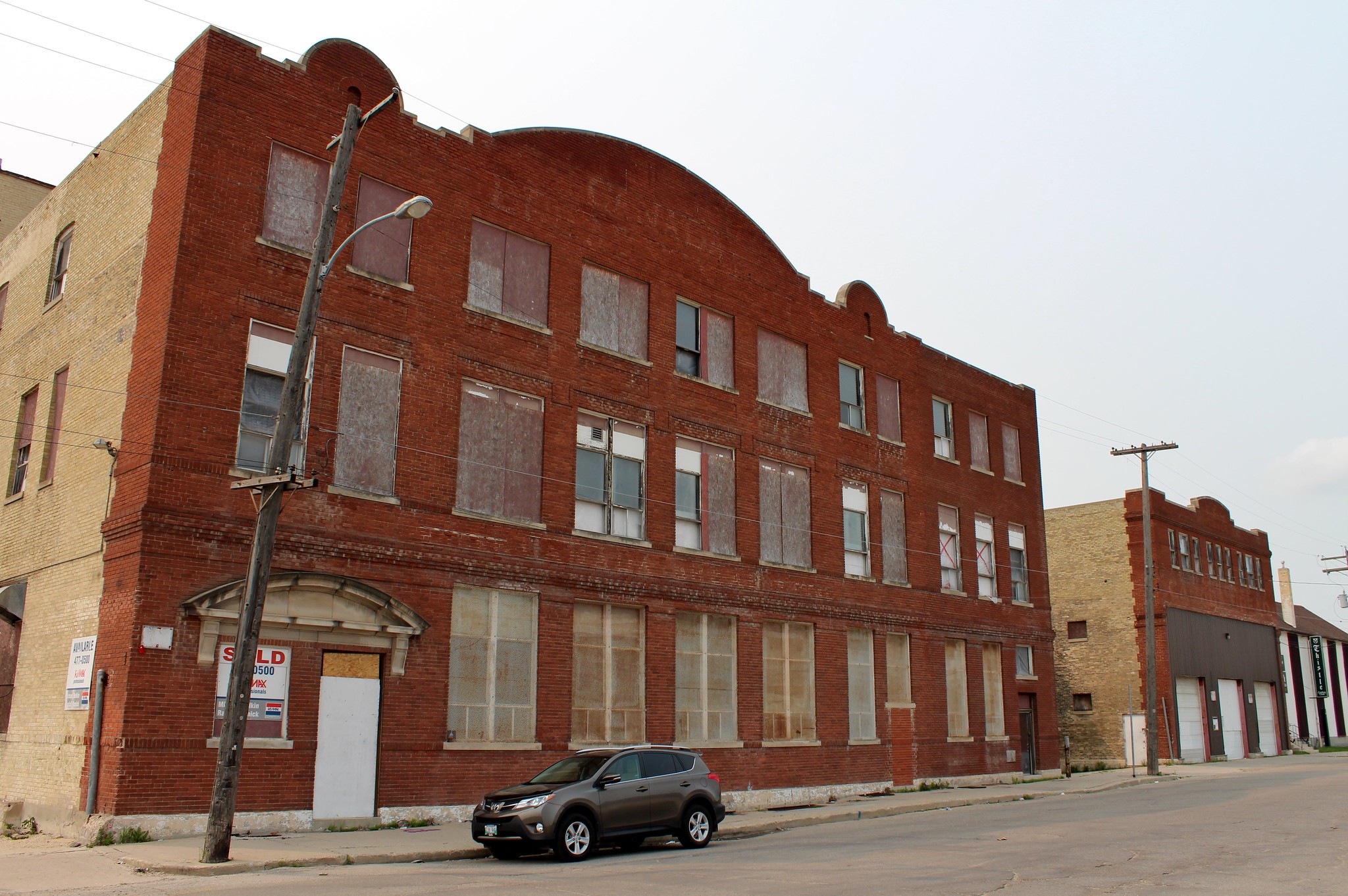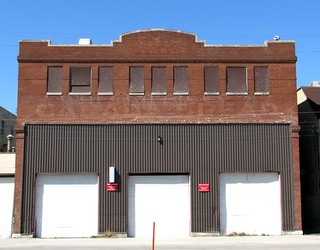Place: Former Canada Bread Bakery
Address: 258 Burnell Street (Map)
Constructed: November 1912
Contractor: George H. Archibald Company
Architect: Unknown
In 1911, Toronto bakery George Weston Ltd. merged with four other Ontario bakeries to create the Canada Bread Company. Within weeks, the new entity announced that it would expand to Winnipeg and Montreal on their way to creating Canada's first national bakery.
Canada Bread bought up a number of local independent bakeries such as Perfection, Western, Germain and Richardson's before they arrived in the city. They also bought a large stake in Spiers Parnell, one of the city's largest bakeries with a plant on Elgin Avenue. The latter was allowed to operate under its own name and management with the caveat that they could not compete directly with Canada Bread's "signature" loaves and cakes.
Bottom: November 9, 1912, Winnipeg Tribune
In October 1911, a $70,000 building permit was issued to George H. Archibald Company and it immediately began work on the three-storey, 72' x 200' bakery. (The smaller building to the north was completed soon after for the 75 horses and wagons used to deliver the bread.)
Construction appears to have gone smoothly and in early November Canada Bread was advertising its new address. The company claimed this was the largest bakery west of Minneapolis with fourteen ovens that could bake four-hundred loaves an hour.
The company hired A. A. Ryley as as the first manager of its Winnipeg operations. An Ontario pharmacist by background, he eventually became a salesman for an Ontario milling company which brought him into contact with Mark Bredin, the man who would become the first general manager of Canada Bread. Ryley was hired in Toronto and dispatched to Winnipeg in 1912.
Under Ryley, the company flourished by doubling its sales in the first two years and soon established itself as the city's largest bakery. The plant underwent an expansion in 1915 that increased its capacity to 250,000 loaves per week. Baking began at 4:30 pm and went through the night.
The following year, the company estimated that it sold 10 million loaves of bread in the city, about one-third of what the city's population would have consumed.
Canada Bread had a large stable of delivery horses. In 1912, they had 75, by 1929 the number was about 130, and in 1940 it had dropped to 40. The horses stuck around even as the automobile became the company's chief mode of transportation to make residential deliveries. It was mostly for public relations. (Many bakeries, creameries and laundry companies did the same thing.)
Getting your bread by home delivery was a little more expensive. In 1938, for example, the price of a basic, unwrapped loaf of white bread cost 6 cents in stores or 7 cents by delivery.
Companies that relied on horses usually specialized in one breed. Eaton's, Crescent Creamery and Canada Bread used Hackneys, while Shea's Brewery and Manitoba Cartage preferred Clydesdales.
Many companies with large stables also showed their best horses and teams at competitions around the region, (the best example of this was Shea's Clydesdales which took national and international prizes some years.) The prized horses became celebrities in their own right. Canada Bread's included Deanstown Helen, Deanstown Nell, Lord Byng, and Billy Sunday, (source).
Eventually, vehicles took over completely. For Canada Bread, there appears to have been a purge of horses in 1939. In 1949 they announced that they were going "all automotive" and sold off what was left of their horses and related equipment.
 Top: Canada Bread truck on St. Matthews Ave ca. 1935 (source)
Top: Canada Bread truck on St. Matthews Ave ca. 1935 (source)Bottom: November 30, 1949, Winnipeg Tribune
A blow to the residential delivery trade was the arrival of the large U.S. supermarket chains, such as Safeway and Piggly Wiggly in 1929-30. In just a few years they each built dozens of new neighbourhood stores.
Over time, the stables building was converted into a garage and loading zone.
There was controversy at the Canada Bread bakery during the Winnipeg General Strike when Helen Armstrong and between 20 to 30 women showed up at the plant. Armstrong was president of the Women's Labour League and in charge of the organizing office of the Bakers, Confectioners and Candy Makers Union on Main Street. The group showed up at the bakery, which hired temporary workers, to disrupt operations.
In their book When the State Trembled: How A. J. Andrews and the Citizens’ Committee Broke the Winnipeg General Strike, Kramer and Mitchell say that the women entered the plant to pull the workers out and were eventually persuaded tho leave the premises by Ryley, (page 79). They moved their protest to the street out front, preventing trucks and workers from entering the building. Tensions rose and “Later the mob forced its way into the shop again, put Riley (sic) up against the wall, and shut off the machinery.”
Police were summoned and Armstrong, Ryley, and another man were arrested for disorderly conduct, (the charges were stayed against all three in July.) The bakery remained closed for a couple of days and about 4,000 loaves of bread had to be discarded due to the disruption.
In mid-June most of the men signed up for the union, apparently with no repercussions from Canada Bread. Ryley, who denied a claim that he was a member of the anti-strike Citizens Committee of One Thousand, appears not to have made any public comments about the strike.
The largest came in 1924 - 25 when the original bakery building got an $80,000 "L" shaped addition. Designed by J N Semmens and built by Wallace and Aikin, it widened the building by 25 feet to the north and added a 200-foot long, three-storey section to the rear.
In 1929, there was another expansion, this time to make room for an 80-foot long electric oven capable of baking 4,000 loaves per hour. Built in Brantford, Ontario, (likely by Baker Perkins). It was said to be the only one of its size in the Commonwealth. The fully automated machine meant that human hands did not touch the product, from the time the raw ingredients were poured to the handling of the wrapped loaves for delivery.
To mark the occasion, on the evening of November 5, 1929 the company held a banquet that featured numerous company and civic officials. After the dinner, it was off to the main floor of the bakery to see the new oven in action.
For the next two weeks members of the public were invited to evening open houses to check it out for themselves.
One of the dignitaries present for the dinner was A. A. Ryley. In 1927, he was appointed general manager of Canada Bread's national operation and returned to Toronto. He spent only about a year in the job before retiring and moving back to Winnipeg.
In November 1930, he was elected to the 1931 city council as an Independent in Ward 2. He kept a low profile the first year but the following year become chair of the Unemployment Relief Committee.
Initially, it was thought that he might be less than sympathetic, considering his background in big business. By most accounts, though, he became a champion for the unemployed, chastising colleagues publicly for not doing enough to provide relief work projects. A Tribune story recounts a blind, unemployed man who appeared before the committee. Ryley was reported to have shed tears as the man plead his case for assistance.
On the night of August 27, 1932 Ryley was at the Winnipeg Water District Railway yard in St. Boniface supervising an incoming delivery of firewood for families on relief. He returned to his home at 623 Banning Street and died of a heart attack.
His body lay in state at city hall the morning before his funeral. He is buried at Elmwood Cemetery.
Given the nature of the work there were very few major incidents associated with the bakery.
As for wartime losses, I can find only one record of a soldier being injured. Herbert Hogben was an employee who lived at 358 Beverley Street when he enlisted with the 44th Reserve Battalion in World War I. He was wounded in action in April 1916, receiving the Military Medal for bravery two years after the incident. He returned to Canada aboard the steamship Lapland in 1919, though does not appear to have returned to Winnipeg.
On June 29, 1943 Rubin climbed into one of the giant mixers to clean dough off of the paddles but did not pull the pin on the safety switch before entering. While he was in there, his assistant, a 21-year employee of the corporation, was given the signal to turn the mixer on. Rubin died of massive trauma and internal injuries. He left a wife and four children ranging from 10 to 19 years of age.
Another employee who was killed on the job was Henry Weir of Morley Avenue. On November 12, 1945 he stopped his bread wagon on River Avenue to make a delivery and was standing in the back doorway when a truck fishtailed into the back of it. Weir was killed instantly.
The driver of the truck had been noticed a block earlier by a police officer, travelling too fast on the icy roads and following the truck ahead of him too closely. The police car pulled out to stop him but before he could catch up, the tragedy happened.
The truck driver claimed he was travelling under the speed limit and that he didn't notice the bread wagon until the truck in front of him pulled out to pass it. He tried to swerve but the side of his truck slammed into the wagon. A corner's jury found him guilty of neglectful driving and he was charged with manslaughter, though the charges were eventually dropped.
From 1939 to 1946, it was a lacrosse field in summer and during the winter months a couple of hockey rinks were added and it was the site of the private West End Orioles Athletic Club's successful hockey program.
In 1947, the land was sold to the Valour Road legion for a curling club and legion hall. In 1948 construction began on the new building and Orioles moved to a site further north on Burnell and became a city funded community club.
On October 2, 1998, the Canada Bread bakery on Burnell Street shipped its last loaves. The company claimed that the aging bakery was only operating at 30% capacity and that many of its loaves and cakes were already being baked under contract by other local bakers, such as Weston's.
After the closure more of their bread would be contracted and they would supply some goods from Edmonton.

The building has sat vacant since the closure.
In November 2011, the city cited the complex under the derelict buildings bylaw. At an April 2012 appeal hearing the owner said that he was "in discussions" with someone who wanted to turn it into housing. An open house was held in December 2012 but plans did not advance beyond that point.
It has since received a couple of reprieves from threats of the city taking it over under the derelict buildings bylaw.
The building was finally demolished over a period of months in late 2019 to early 2020.
Related
My Flickr album of the former Canada Bread bakery
A history of Burnell's Bakeries West End Dumplings
Open house re: Canada Bread's former Burnell bakery West End Dumplings


















Great research and clear presentation. Fun to read if you're interested in local history. Makes me wonder why the bread company didn't sell it years ago
ReplyDeleteGreat article. Many years ago (another lifetime, really) I used to walk past this place to and from work, enjoying the smell of fresh bread wafting through the neighbourhood. I can only imaging what it might have been like when it was at full capacity, feeding a hungry and growing Manitoba. Thank you for this. -- V.R.
ReplyDelete